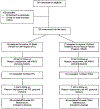A pedometer-based intervention to improve physical activity, fitness, and coronary heart disease risk in National Guard personnel
- PMID: 21634310
- PMCID: PMC6201301
- DOI: 10.7205/milmed-d-10-00256
A pedometer-based intervention to improve physical activity, fitness, and coronary heart disease risk in National Guard personnel
Abstract
To compare the effects of a pedometer-based behavioral intervention (Fitness for Life [FFL] program) and a traditional high-intensity fitness (TRAD) program on physical activity (PA), Army Physical Fitness Test (APFT), and coronary heart disease risk factors in Army National Guard members who failed the APFT 2-mile run. From a pool of 261 Army National Guard, a total of 156 were randomized to TRAD or FFL for 24 weeks consisting of a 12-week progressive conditioning program followed by 12 weeks of maintenance. For both groups, the total APFT score and 2-mile run time/score improved from baseline to 12 weeks (FFL: down 7.4%, p = 0.03; TRAD: down 5%, p = 0.08) but at 24 weeks they had regressed toward baseline. PA improved modestly and coronary risk profile changed minimally in both groups. A pedometer-based exercise intervention had results similar to a high-intensity program for improving PA, APFT, and 2-mile run times/score. Neither group sustained the improved run times over the 12 weeks of maintenance.
References
-
- Klerman JA: Rethinking the Reserves. Santa Monica, CA, RAND Corporation, 2008.
-
- Davis L, Polich JM: Army stretched thin: There’s no easy way out for the nation. RAND Review. Summer 2005; 29(2): 12–5.
-
- Government Accountability Office: Report to Congressional Committees: Military Personnel: Top Management Attention is Needed to Address Long-Standing Problems with Determining Medical and Physical Fitness of the Reserve Force Document No GAO-06–105. Washington, DC, GAO, October 27, 2005.
-
- Talbot L, Weinstein A, Fleg J: Army Physical Fitness Test scores predict coronary heart disease risk in Army National Guard soldiers. Mil Med 2009; 174(3): 245–52. - PubMed
-
- Stutts W: Physical activity determinants in adults. Perceived benefits, barriers, and self efficacy. Am Assoc Occup Health Nurse 2002; 50(11): 499–507. - PubMed


